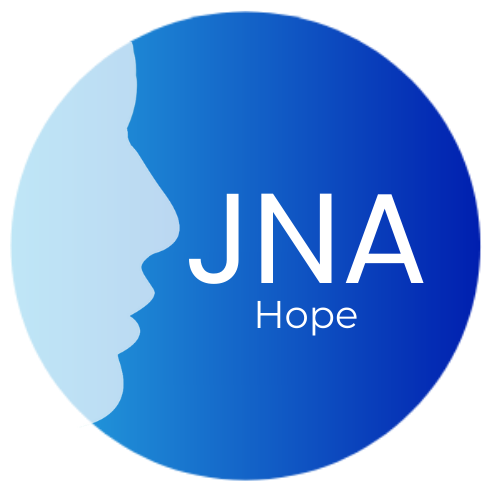
Understanding JNA Symptoms:
What Parents Should Watch Out For
When it comes to Juvenile Nasopharyngeal Angiofibroma (JNA), understanding the symptoms is crucial for early detection and timely intervention. As parents, being vigilant about certain signs can make all the difference in your child’s health. Here, we break down four key areas to watch out for.

Trouble Breathing
- Difficulty breathing through one side of the nose.
- Persistent runny nose.
- Sleep disturbances, such as snoring or sleep apnea.


Trouble Breathing
- Difficulty breathing through one side of the nose.
- Persistent runny nose.
- Sleep disturbances, such as snoring or sleep apnea.
One of the hallmark signs of JNA is difficulty breathing, often due to the tumor blocking the nasal passages. Parents may notice that their child predominantly breathes through one nostril or that their child experiences frequent nasal congestion. Sleep disruptions, like snoring or sleep apnea, may also occur due to airway obstruction.
What It Might Be Mistaken For:
These symptoms can initially be mistaken for common respiratory issues or allergies. Parents might attribute nasal congestion to seasonal allergies or colds. Sleep disturbances may be thought of as common childhood snoring.


Internal Issues
- Headaches or pain in the upper areas of the face (sinus pain).
- Changes in vision, such as blindness or double-vision.
- Loss of sense of smell or hearing loss.
- Speech difficulties.
JNA can cause a range of internal issues. Headaches or facial pain, often felt in the sinus area, can be indicative of tumor growth. Changes in vision, including blindness or double-vision, may occur if the tumor affects the optic nerve. Loss of smell or hearing issues can also develop due to tumor compression. Additionally, speech difficulties may arise if the tumor impacts the adjacent structures.
What It Might Be Mistaken For:
These symptoms can sometimes be mistaken for sinusitis, migraines, or other neurological conditions. Vision changes may initially be attributed to eye strain or unrelated eye problems. Speech difficulties may raise concerns about developmental issues in younger children.


Internal Issues
- Headaches or pain in the upper areas of the face (sinus pain).
- Changes in vision, such as blindness or double-vision.
- Loss of sense of smell or hearing loss.
- Speech difficulties.
JNA can cause a range of internal issues. Headaches or facial pain, often felt in the sinus area, can be indicative of tumor growth. Changes in vision, including blindness or double-vision, may occur if the tumor affects the optic nerve. Loss of smell or hearing issues can also develop due to tumor compression. Additionally, speech difficulties may arise if the tumor impacts the adjacent structures.
What It Might Be Mistaken For:
These symptoms can sometimes be mistaken for sinusitis, migraines, or other neurological conditions. Vision changes may initially be attributed to eye strain or unrelated eye problems. Speech difficulties may raise concerns about developmental issues in younger children.

Facial Appearance
- Change in facial appearance, such as swelling in the cheeks, mouth, or face.
- Watery eyes.
- Droopy eyelids and bulging eyes.
- Facial numbness.

JNA can lead to noticeable changes in facial appearance. Swelling in the cheeks, mouth, or face may occur due to tumor growth. Watery eyes, droopy eyelids, and bulging eyes can result from pressure on the surrounding structures. Facial numbness can also manifest if nerves are affected.
What It Might Be Mistaken For:
Facial swelling might initially be perceived as an allergic reaction or dental issue. Watery eyes could be thought of as allergies or eye irritation. Droopy eyelids and facial numbness may raise concerns of various neurological conditions.


Facial Appearance
- Change in facial appearance, such as swelling in the cheeks, mouth, or face.
- Watery eyes.
- Droopy eyelids and bulging eyes.
- Facial numbness.
JNA can lead to noticeable changes in facial appearance. Swelling in the cheeks, mouth, or face may occur due to tumor growth. Watery eyes, droopy eyelids, and bulging eyes can result from pressure on the surrounding structures. Facial numbness can also manifest if nerves are affected.
What It Might Be Mistaken For:
Facial swelling might initially be perceived as an allergic reaction or dental issue. Watery eyes could be thought of as allergies or eye irritation. Droopy eyelids and facial numbness may raise concerns of various neurological conditions.


Frequent Nosebleeds
- Frequent or severe nosebleeds.
- Nasal obstruction, causing breathing difficulties.
Nosebleeds are a common and distinct symptom of JNA. These nosebleeds can be frequent and severe due to the tumor’s vascular nature. Nasal obstruction may also occur, further complicating breathing.
What It Might Be Mistaken For:
Nosebleeds might be initially attributed to dry air, allergies, or minor nasal trauma. Nasal obstruction may be mistaken for allergies or respiratory infections.


Frequent Nosebleeds
- Frequent or severe nosebleeds.
- Nasal obstruction, causing breathing difficulties.
Nosebleeds are a common and distinct symptom of JNA. These nosebleeds can be frequent and severe due to the tumor’s vascular nature. Nasal obstruction may also occur, further complicating breathing.
What It Might Be Mistaken For:
Nosebleeds might be initially attributed to dry air, allergies, or minor nasal trauma. Nasal obstruction may be mistaken for allergies or respiratory infections.

In summary, being aware of these JNA symptoms
is essential for parents.
While some of these signs may resemble common childhood ailments, any persistent or unusual symptoms should prompt consultation with a healthcare professional. Early detection and intervention can greatly impact the outcome and well-being of a child with JNA.
